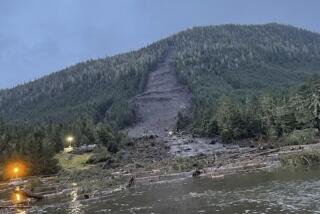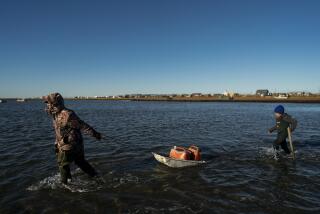Remains of Early Migrants Being Studied in Alaska
KODIAK, Alaska — The remains left by some of the earliest migrants from Asia to Alaska and the remains of the first Russian colony in North America are being simultaneously uncovered on Alaska’s Kodiak Island.
Archeologists said Kodiak Island, jutting out of a volcano-formed archipelago in the Gulf of Alaska, is proving to be a treasure trove of artifacts left by North America’s earliest settlers.
“It’s like being in a candy shop. There are sites everywhere,” said Philomena Knecht, a doctoral candidate at Harvard University who leads one of several excavations on the island.
Knecht’s site, in the community of Chiniak on the east side of the island, shows evidence that the migrants from Asia had developed sophisticated tools to hunt marine mammals.
That makes them more advanced than the earliest Bering Strait migrants, who settled along what is now the Aleutian Island chain about 10,000 years ago. They gathered food along the shorelines and fished with simple techniques, she said.
In the last three years, she and her workers have uncovered the floors of several prehistoric homes, sea mammal bones, human bone fragments, hunting tools and pieces of a seal-oil lamp--strong evidence, she said, that the people were ancestors of today’s Eskimos.
The evidence indicates that these were the among the first Alaskans to learn maritime hunting skills, she said.
The site, 6,500 years old, is one of the earliest traces in Alaska of a maritime culture termed Ocean Bay by archeologists, she said.
“It’s a definite link to Asia. There’s just no question that these people are coming in from Asia,” she said.
“Minimally, we’re looking at the earliest ancestors of Eskimos and Aleuts,” said Rick Knecht, Philomena’s husband and an archeologist also specializing in the Ocean Bay culture.
While Philomena Knecht scrapes away at her prehistoric Aleut site, her husband works farther south on the island, uncovering the earliest Russian settlement in Alaska.
Rick Knecht, working for the region’s Aleut Corporation and for the University of Alaska at Anchorage, has joined forces with a prominent Soviet archeologist to excavate the site.
“It’s the first Russian settlement in Alaska,” Knecht said.
He said the site was believed to have been established in 1784 by an expedition led by Grigor Shelekhov of the Russian American Co.
Knecht said archeologists have known since the 1960s about the Russian settlement site on Kodiak Island but have only recently gathered the experts and the funding to conduct the excavation.
The project, begun this year, is a joint U.S.-Soviet effort that grew out of renewed ties between the Soviet Union and its former colony, which Russia sold to the United States in 1867.
More to Read
Sign up for Essential California
The most important California stories and recommendations in your inbox every morning.
You may occasionally receive promotional content from the Los Angeles Times.










